What is Hainanese Chicken Rice? Glad you asked. Put simply, a dish adapted from early Chinese immigrants from Hainan Island, off the southern coast of China, known indigenously as Wenchang chicken. The Hainanese use a particular fowl that is bony and fibrous, and serve the chicken with oily rice. The chicken is steeped in boiling water or blanched until it is fully cooked before soaking in cold water to ensure the meat remains tender.
In a local twist, the chicken can also be roasted or braised in soy sauce for a different taste.
Grassland’s sommerlad Heritage chicken is perfect for this dish, because it’s the closest bird to an Asian Jungle fowl available to Australia, in taste, texture, and behaviour.
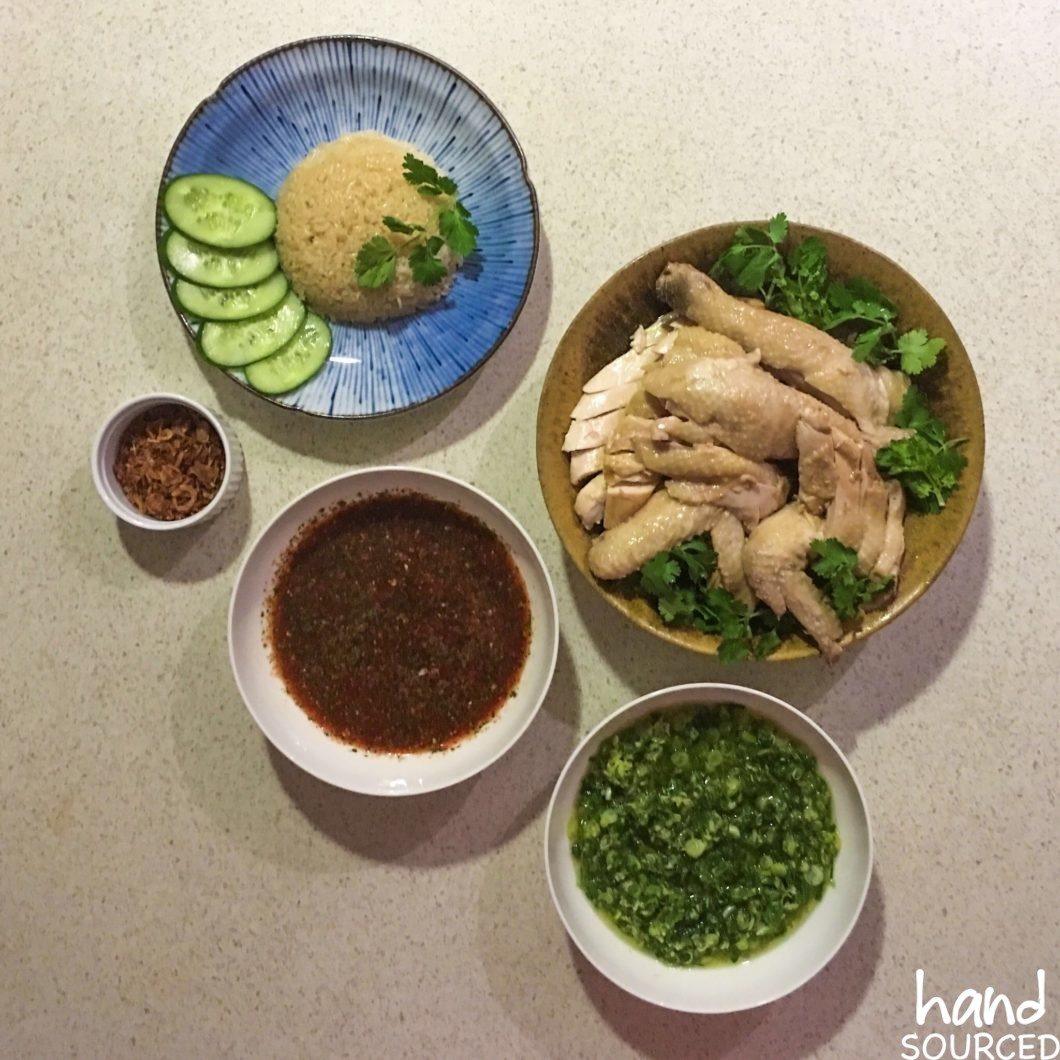
This recipe, adapted and adjusted by Eliot Roberts, uses the Sommerlad; the depth of flavour and long, strong nutritious bones that give this dish an alignment with the original that simply cannot be replicated by a standard broiler.
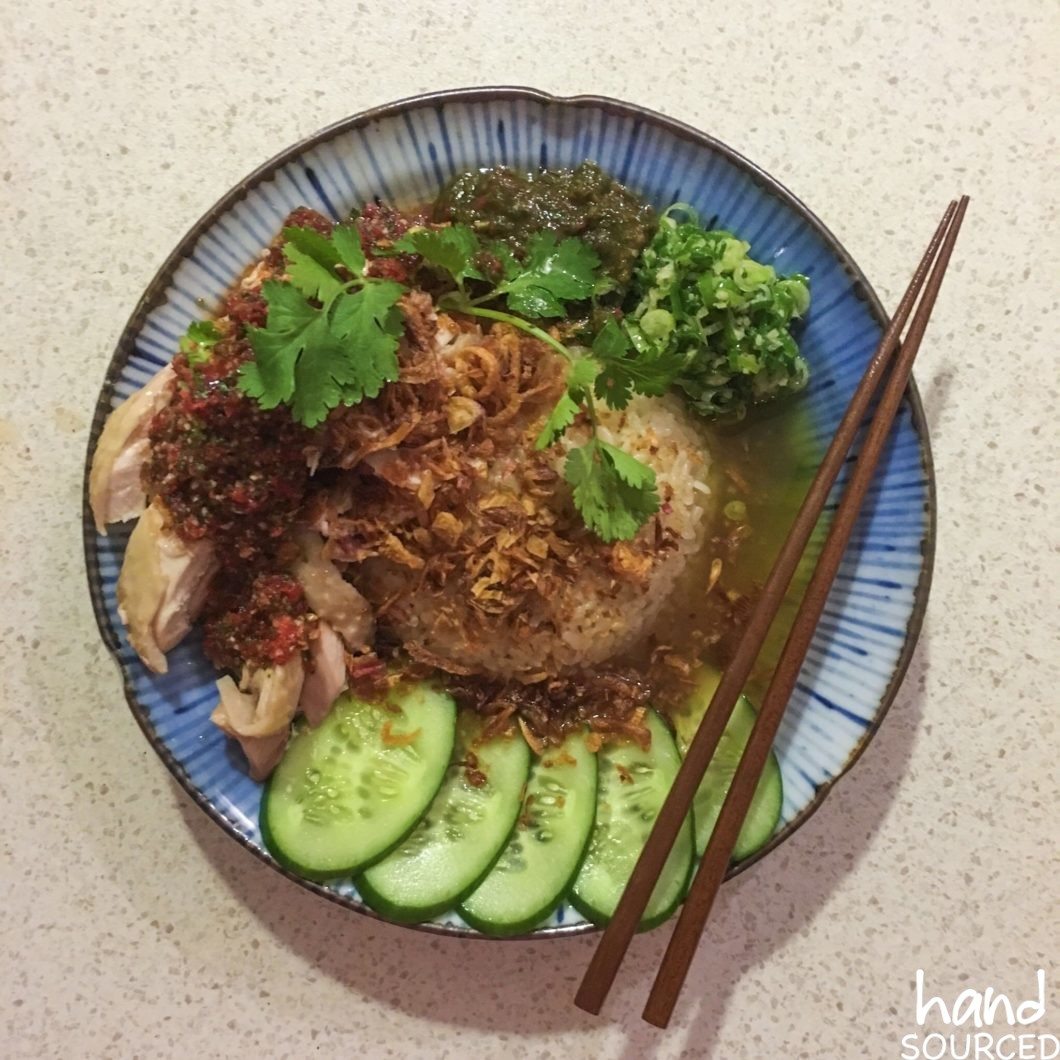
It might look long – it is – but the steps are simple and the results well worthwhile.
Hainanese Sommerlad Chicken Rice
Ingredients
The Red Sauce
- 3-4 long red chillies, roughly sliced (remove the seeds if you wish)
- 3 cloves garlic, peeled, roughly sliced
- 1 tbsp. finely chopped coriander
- ⅓ cup (80 ml) white vinegar
- ⅓ cup (80 g) caster sugar
- ½ tsp. salt
The Green Sauce
- 8 – 10 stalks spring onions, finely sliced
- 10 cm piece of young ginger, peeled, finely minced
- 2 tsp. salt
- 2/3 cup rice bran or peanut oil
The Brown Sauce (Optional –substitute with kecap manis if you would prefer)
- 2 cups well packed coriander leaves and stalks, finely chopped
- 2 stalks spring onions, finely sliced
- 2 long red chillies, roughly sliced (remove the seeds if you wish)
- 2-3 tbsp. hoisin sauce
- Caster sugar (to taste)
- ½ cup Water
The Chicken
- 1 (1.5 – 1.8kg) whole Sommerlad chicken with Parson’s nose and fat surrounding cavity cut away and reserved
- 2 tbsp. fine cooking salt
The Broth
- 1 – 2 cloves garlic, bashed
- 10 cm piece of ginger, sliced and bashed
- 5 spring onions, knotted together
- 1 handful of coriander stalks
- 3 tbsp. Shaoxing wine
- 3 tbsp. light soy sauce
- 3 – 4 litres of water
The Rice
- 2 cups jasmine rice
- 2 cloves garlic, peeled, finely chopped
- 2 slices ginger, 5 mm thick, bashed
- 1 pandan leaf, fresh or frozen (usually available from a good Asian grocer)
- Reserved rendered chicken fat, or substitute 1 tbsp. rice bran or peanut oil
- 2 cups chicken stock, from poaching chicken feet, carcasses or bones
To serve
- Red Sauce, Green Sauce and Brown Sauce
- Fried Shallots (Simon Johnson if you haven’t got time for home made)
- Coriander for garnish
- Sesame oil to brush on the poached chicken skin
- Sliced Lebanese cucumber
- Reserved crispy chicken skin from fat renderings
Prep:
Cooktime: 1 hr approx
Serves: 4
Instructions
Prepare the sauces beforehand, unless you have someone to help you in the kitchen or are a multitasking pro.
For the red sauce, blitz all ingredients in a food processor until smooth. If you’re feeling dedicated, by all means mince all items by hand and combine in a pestle and mortar.
For the green sauce, slice the spring onions, mince the ginger and sprinkle the salt on the top. Combine and mix in a heatproof bowl or saucepan and place it in your sink or outside – this can get messy. Heat your oil to smoke point, and then pour over the sauce mixture. It will spit and crackle and be completely delicious. Mix well and reserve, covered, at room temperature.
For the brown sauce, combine the coriander, spring onions and red chilli in a food processor, and give it a pulse. Add the hoisin sauce. Give it another pulse until it just comes together. Add the water. Have a taste – if it requires more sweetness, add some caster sugar. Hoisin itself can be quite sweet, so I often don’t bother, but that will depend on the brand used. Transfer this mixture to a small saucepan and bring it to the boil, stirring constantly. Once boiling, remove from the heat and set aside in a bowl to cool in the fridge. This sauce is not strictly traditional, I suspect it is something my mother-in-law has made up herself, however it is delicious and we do love it. If you’d prefer, you can substitute the brown sauce with kecap manis.
For the chicken cut the parson’s nose and fat surrounding the inner part of the chicken cavity away and mince it coarsely, I find this helps it render. Place it in a pan or saucepan on a low heat to render the fat. I usually leave it 20 – 30 minutes, or until the chicken skin in the pan is a crisp golden brown and the fat has rendered out. Reserve the fat and the crispy chicken skin. (Note: If chicken fat isn’t your style, you can substitute rice bran or peanut oil later on in the recipe.)
While this is rendering, I get on with prepping the chicken.
Place the chicken on a plate or board in your sink, and ‘exfoliate’ the chicken skin with the 2 tbsp. of salt, this is to purify the skin and remove any contaminates, it also contributes to a beautiful gelatinous skin on the cooked bird (Note: If you’re not a lover of chicken skin and don’t eat it, you can omit this step.) After the chicken has been thoroughly exfoliated, rinse it well with cold running water.
Prepare the broth ingredients and stuff the chicken with some of them, placing the rest of them in the pot with the chicken.
When selecting a pot, make sure you select something with enough room to completely submerge the chicken, and make sure it has a tightly fitting lid. I find a tall stock pot works well.
Cover the chicken and broth ingredients with water. Bring this mixture to the boil and skim any impurities which form on the surface. Once at a rolling boil, remove from the heat, put the lid on the pot and leave it for 45 minutes to an hour. The residual heat will cook the chicken through without drying out the breast meat. (Note: if using an enamelled cast iron pot, the chicken may cook quicker – test it at the 45 to 50-minute mark).
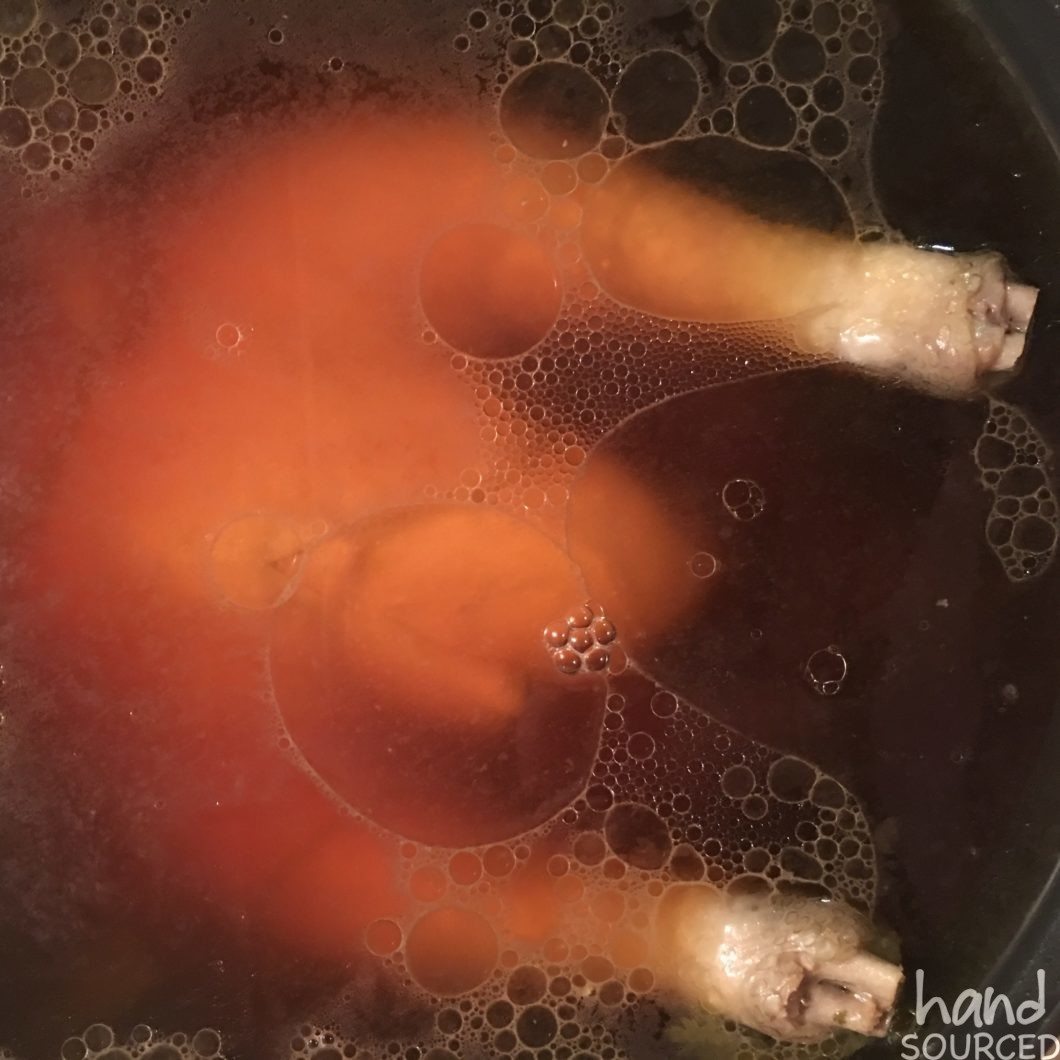
Half way through the cooking of the chicken, start preparing the rice.
Rinse the rice really well. If you think you’ve rinsed it enough – go one more time, just to make sure. After the rice has been rinsed, soak it in water for 20 minutes and then drain it thoroughly.
While the rice is soaking, smash your ginger and finely mince your garlic, tie your pandan leaf in a knot.
Once the rice is drained, place a fry pan on the heat and heat up the chicken fat from earlier. Add the ginger, and then the garlic being careful not to take it too far – no one likes burnt garlic.
Add the drained rice and fry it off for a few minutes with the garlic and the ginger. After the rice has gone glossy, transfer the mixture to your rice cooker, along with the pandan knot.
At this stage, test the chicken with a thermometer for doneness – I aim for 65 to 70 degrees on the inner part of the thigh. (Note: If you have a sous vide machine, place your ingredients in a vacuum bag and set the chicken to the temperature of your choosing. If cooking sous vide above 70 degrees, try not to go over two hours as I find it starts to impact the textural quality of the breast meat.)
Once the chicken is cooked, remove it from the broth and let it rest on a plate. Paint the skin with sesame oil and cover with foil.
Add two cups of the broth to the rice cooker, and set it to work. (Note: If you’re somewhat of a rice-pro, by all means cook the rice on the stove top using the absorption method, with a ratio of 1:1 rice to stock. My partner looks after all rice responsibilities in our household and I get on with other things, such as pouring the wine).
While the rice is cooking, carve the chicken. Remove the breasts, being careful to retain the skin on the breast meat. Chop the breast against the grain and put it aside for plating. Remove the Maryland’s, and cut out the thighbone. Chop the thigh across the grain. Plate the meat up with the legs and wings on the side. Brush the meat with more sesame oil and garnish with fresh coriander. I like to pick all the remaining meat off the carcase and reserve this for my plate – these are usually the best bits, but to be honest it is all wonderful.
Serve the chicken with the rice and cucumber slices. Add sauces to your preference as well as a good sprinkling of fried shallots some of the fried chicken skin for texture.
You can also serve the broth as soup, however I don’t usually bother – we just aren’t chicken soup lovers. I have seen the broth served as-is, as well as with finely chopped wombok and spring onion.
I don’t waste the broth– as I add the chicken frame back to the broth and let it reduce by half, and then freeze until next time I am ready to make Hainan chicken rice.
This is then my base – to which I add fresh water and the aromats – somewhat in the style of a master stock.
Alternatively, the broth can be used as a good stock in other Asian style dishes.
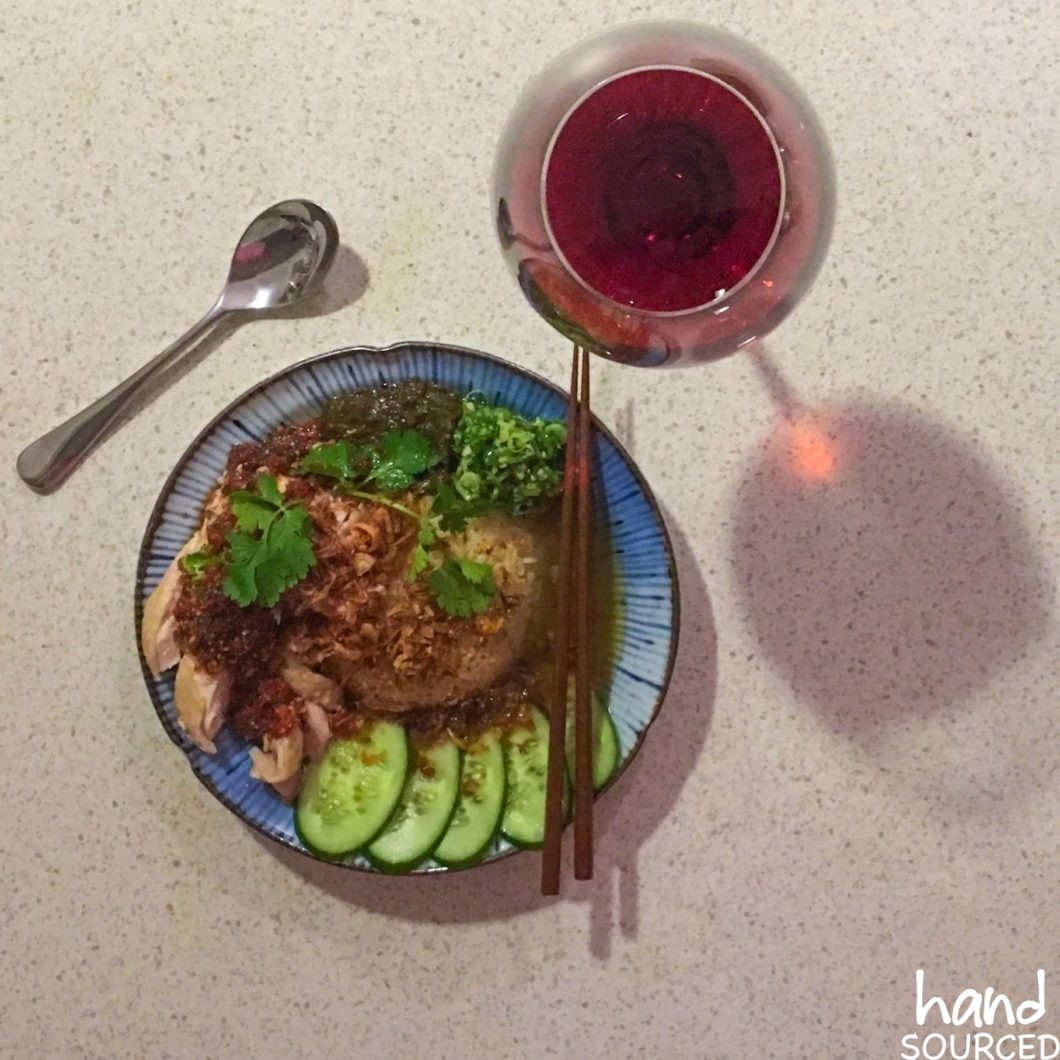
If you’re on a quest to perfect this dish and make it your own, Eliot suggests the following for further reading and research:
SBS Food Safari – Food Safari’s Hainanese chicken rice
SBS Food – Chinese – Poh’s Hainanese chicken rice
Chefsteps.com – Whole Poached Chicken (Sous Vide)
Itsmydish.com – Mike vs Jeff – Sous Vide Challenge
FoodCanon.com – Making delicious Hainanese chicken rice
Eliot Roberts describes himself as “a passionate and adventurous home cook who appreciates beautiful ingredients”. The former top 100 Masterchef contender grew up on the land, his father’s property providing the meat; the fruit and vegetables sourced from his grandfather’s spoils. His early food years bypassed the Little Golden Books, the magic instead coming from his mother’s collection of Time Life’s ‘The Good Cook’ Collection. He still has the collection and adores them to this day.
Eliot has a keen interest in Chinese Malay cuisine, and he and his partner are currently entrenched in exploring traditional Nyonya and Chinese specialities as guided by their family ties.
All photos and recipe text courtesy of Eliot Roberts, used with permission.
Buy Grassland’s Sommerlad Heritage Chicken here.
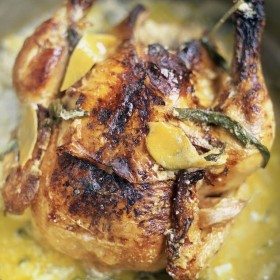
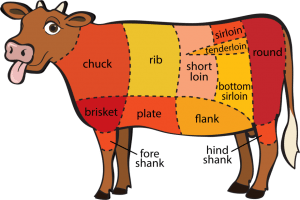

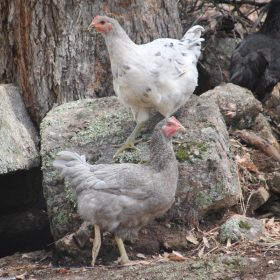
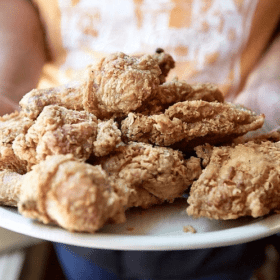

Leave a Reply